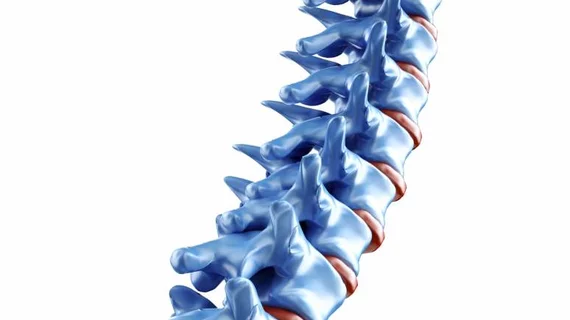When interpreting the same trauma patient, body radiologists miss more acute spinal fractures than neuroradiologists
When CT is utilized to image a trauma patient, two subspecialty radiologists—neuroradiologists and body radiologists—often interpret the patient’s thoracic and lumbar spine. The two subspecialists don’t always agree on the presence of an unequivocal acute fracture, according to a new study published in the Journal of the American College of Radiology. Body radiologists miss more acute spinal fractures than neuroradiologists.
The authors studied more than 1,400 cases from their institution that involved neuroradiologists and body radiologists interpreting the thoracic and lumbar spine of the same patient. Overall, a disagreement about the presence of an unequivocal acute fracture occurred more than 2 percent of the time. In one instance, both radiologists missed a fracture. When only one miss occurred, it was missed by the body radiologist 82 percent of the time and the neuroradiologist 18 percent of the time.
“Although this discrepancy may seem small, it is alarming when considered in the context of the number of trauma patients per year scanned at our centers.” wrote Franco Verde, MD, with the Russell H. Morgan Department of Radiology and Radiological Science at Johns Hopkins Medical Institution in Baltimore, and colleagues.
Their institution’s disagreement rate was comparable to ACR RADPEER’s 2.91 percent disagreement rate, the authors added, but RADPEER “represents a difference process.”
So, why were most disagreements the result of a body radiologist missing a fracture? Verde et al. noted that the exact reasoning is “unknown and likely multifactorial.”
“Experience and education may be contributing factors,” the authors wrote. “Given that neuroradiologists are frequently tasked to evaluate the spine for degenerative disease, they may have more experience detecting fractures and subtle abnormalities compared with body radiologists. Furthermore, the standard report completed by neuroradiologists is highly detailed and, at our institution, requires a comment for each vertebral level. In contrast, body radiologists comment on spinal fractures when apparent but do not evaluate each vertebra level by level.”
The authors also explained that conservative therapy was recommended in most instances when there was a difference of opinion between the two radiologists, adding that “it is difficult to gauge the clinical impact of missed fractures.”

